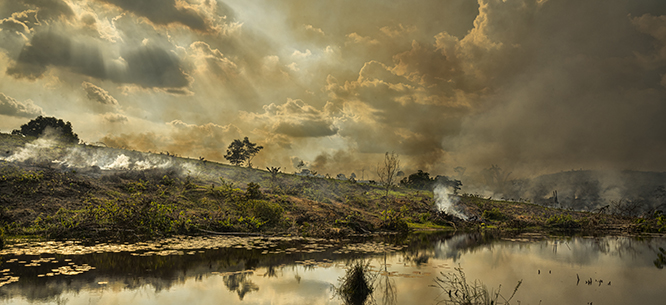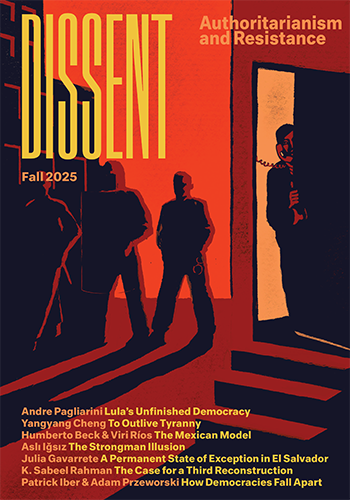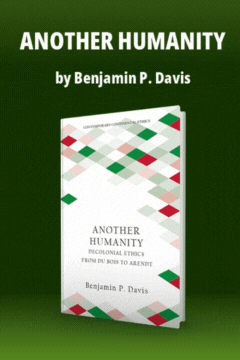The Value of Nature
The Value of Nature
Why have some gifts of nature remained free?

In classical political economy, natural agents appear as contributors to production, conventionally understood: sheep’s viscera help produce wool; wind drives the sails of merchant ships; fertile soil helps crops grow. But each of these is dependent on countless others that go unmentioned. Soil is “produced” by countless worms, fungi, mites, and other insects, which decompose organic debris and transfer nutrients between plants. Bacteria in the sheep’s gut help the sheep digest grass; bees pollinate the plants the sheep eat; the plants capture solar energy and convert it to a form the sheep can process—which brings us back to the soil. Even the wind wouldn’t blow in the same way without temperature patterns linked to global climate regulation, itself maintained by a complex array of living systems. These natural agents don’t go directly into commodity production—but they regenerate the ones that do. More than that, they constitute Earth’s “life support systems”—the carbon cycle, water purification, soil fertility, and other elements that make the planet habitable. Thus, anthropologist Anna Tsing argues, “making worlds is not limited to humans.” Rather, “all organisms make ecological living places, altering earth, air, and water.” These multispecies activities are more than world-making: they are planet-making. The actions and interactions of various life forms, from amoebas to sequoia, have over millions of years shaped Earth’s very geology and atmosphere so significantly as to make it a qualitatively different kind of planet than Mars or Venus.
These planet-making abilities, however, are in serious decline. “We are currently damaging [the natural world] so profoundly that many of its natural systems are now on the verge of breakdown,” David Attenborough warns. Warning signs have long been on the horizon. In 1973, amid debates about resource scarcity and the limits to growth, the economist William Nordhaus noted—in a piece otherwise refuting ecological doomsaying—that “if the price system malfunctions, as is currently the case for free but scarce public environmental resources—then perverse outcomes are possible.” Five decades later, this “malfunction” persists, and perverse outcomes have materialized. “The value of natural entities such as mangroves, wetlands, and coral reefs,” the economist Partha Dasgupta observes, lies in their contributions to human well-being, which “don’t appear in the marketplace.” As the ecologist Gretchen Daily argues, “The disparity between actual and perceived value is probably nowhere greater than in the case of ecosystem services.” Two common strategies for rectifying this disparity have emerged.
The first strategy proposes to price nature, often described in terms of “natural capital” or “ecosystem services,” intended to draw attention to ecosystems’ economic contributions. It is exemplified by a statement by Henry Paulson, former secretary of the U.S. Treasury, and now a staunch advocate for natural capital valuation: “People assume that natural capital is a free good, and if you don’t put a value on it, they will value it as zero.” Like it or not, this position holds, goods are assessed in terms of their monetary value. If nature is to be protected, it must have a price: its use and exchange value must be brought more closely into alignment, whether by requiring “payment for ecosystem services,” accounting for natural capital, or creating markets in “natural assets.” The goal, in the words of the biologist Edward O. Wilson, is “to give the invisible hand of free-market economics a green thumb.”
The second strategy, a moral critique that insists on nature’s pricelessness, has developed in vehement opposition to the first. Critics argue that price is an inappropriate metric for the more-than-human world, one that degrades or diminishes precisely what it seeks to capture. Some things should not be for sale, they argue—and nature is one of them. “Dear neoliberal economists,” André Gorz asked scornfully in 1983, “how much is a ray of sunlight worth? Fresh air without lead or sulphur fumes?” Instead of trying to translate the intrinsic, ethical, or aesthetic value of nature into monetary terms, Gorz and others insist, we must learn to value nature in ways that can’t be costed.
Advocates of pricing nature correctly identify the problem: that in a world of generalized commodity exchange, things without exchange value are treated as worthless. Critics, meanwhile, rightly identify the gap between exchange value and other kinds, indexing a critique of capitalism’s form of value even where capitalism is not invoked directly. Yet while these strategies—to value nature in terms of price, or to protect nature from price—point in opposite directions, neither has been successful. Efforts to price nature have repeatedly failed to make certain kinds of nature valuable in economic terms, however impoverished those terms may be. Efforts to render nature priceless, meanwhile, have failed to protect it from the market.
Nature is a free gift by default. It can’t appear in the marketplace in its own right, and it can’t demand a wage for its services, however valuable they might be. To have a price, it needs a human representative—which is to say it needs an owner. And if Western thought has often conceived of nature as a gift from God to all of humanity in common, it has just as often defended its appropriation as private property. Nature’s gifts, for many, are meant to be alienated and owned, worked and improved. Most obviously, John Locke’s foundational account of property describes the process of enclosing nature’s gifts: the observation that God had given the Earth to “men” in common is for Locke simply a prelude to explaining how an individual might justifiably claim it as his own. The role of labor in making land productive is key to this argument: land “left wholly to Nature,” Locke argues, is merely “waste.” Locke’s account of ownership conveniently justified the expropriation of land from Indigenous peoples of the New World. It also, Marx charged, concealed the violent appropriation of commons used by English peasants—the process of “so-called primitive accumulation,” capitalism’s original sin.
Many of capitalism’s other critics have tracked its advancement via the continued process of enclosure—not least, of ever more gifts of nature. Already in the sixteenth century, Thomas Müntzer, the radical theologian and leader of the German Peasants’ War, lamented that “all creatures have been turned into property, the fishes in the water, the birds in the air, the plants on the earth,” declaring that “the creatures, too, must become free.” Four centuries later, the political scientist James C. Scott would ruefully describe “the inexorable incorporation of what were once thought of as free gifts of nature: forests, game, wasteland, prairies, subsurface minerals, water and watercourses, air rights . . . breathable air, and even genetic sequences, into a property regime.” We should not be surprised, in other words, to find capital enclosing the free gifts of nature. This, after all, is where capital begins. What is surprising, however—and what requires attention—is the fact that some gifts remain free; that even today, some—indeed, many—creatures have not yet been turned into property. If capitalism relentlessly commodifies, why are ecosystem services still “valued as zero”? Why have some gifts of nature remained free?
It is not for lack of trying. The uncultivated land that Locke dismissed as mere waste is now figured as the site of potentially valuable ecosystem services. The past few decades have seen the proliferation of programs in “natural capital accounting” and companies purporting to trade in “natural assets,” proclaiming ecological nature to be a source of untapped value—and a corresponding rash of critiques decrying the commodification of life itself. But the gifts of nature described in terms of natural capital and ecosystem services have proved remarkably difficult to make into property. Critics of commodification have misidentified the problem afflicting the biosphere: not that capital has absorbed all of life, but that it has abdicated responsibility for so much of it.
Ecosystems are ultimately better thought of as infrastructures rather than commodities: as systems that support a range of other activities rather than as discrete goods or services to be exchanged directly. This perspective on ecosystems reorients attention away from moral debates about commodification, and toward political questions: What kind of work do ecosystems do, and for whom? What kinds of ecosystem public services do we need to make our planet a livable one for humans and nonhumans alike?
Planetary ecosystems are presently in a dire state. For decades, capitalism has proposed to hold the solutions: in new forms of property rights, new kinds of markets, new representations of concrete natures in abstract terms. Public, private, and nonprofit sectors have constructed an elaborate labyrinth of social and economic institutions—in the words of the geographer Erik Swyngedouw, “a truly Stalinist-bureaucratic institutional structure”—in service of making nature into credits, capital, or assets; buying and selling ecosystem services; pricing nature to save it. Recent speculations about markets in “natural assets” are only the most recent iteration of a dream, now over three decades old, of unlocking the wealth that nature’s free gifts seem to hold. So far, however, its realization remains elusive. Making ecosystems into revenue-generating property—let alone growth-stimulating assets—is enormously complicated and rarely successful.
Actually protecting ecosystem services, however, is much simpler. For the most part it just means preserving swathes of land large enough to keep ecological relations intact—and then leaving them alone. Ecosystems are, in a sense, already socialized, insofar as their physical qualities resist the relations of private ownership; they are already automated, in that they largely work on their own, with a bit of maintenance here and there. Why work so hard to make them monopolizable by private interests instead of embracing them as a public good? Why, put simply, should the state go to so much trouble to privatize and capitalize nature instead of socializing it?
The socialization of nature, philosopher Jacob Blumenfeld argues, would “take ecosystems seriously as sites of political contest and coordinated planning, so that non-monetary questions about the value of nature can even be asked in the first place, and proactively planned for in accordance with multiple criteria of human and non-human flourishing.” It would be what we might think of as a form of conscious planet-making. Conscious planet-making does not mean indulging in the fantasy that we can engineer the Earth to precise specifications or bring it under total control—neither of which, I think, is either possible or desirable. It simply means taking collective responsibility for maintaining, remaking, and cultivating the multispecies worlds upon which human beings rely not only for mere survival but for lives that are pleasurable, fulfilling, and meaningful.
World-making has often been conceived as a distinctively human practice. For Hannah Arendt, the world is a human world of durable artifacts, which can withstand the perpetual cycles of nature. When we make the world, we make a lasting place for human beings to act and appear. The “durable human world” itself, however, is constituted not only by the exclusively human action of homo faber but by the activities of the more-than-human world, which Arendt classifies as the ostensibly ephemeral cycles of labor. “Natural” entities like old-growth forests or wetlands may be durable, worldly things, potentially lasting thousands of years—and they too are the subjects of human cultivation, meaning making, and care. They exist not only in “cyclical” patterns but have their own histories of change and disruption as well as ongoingness, which are intertwined with and perhaps now inseparable from human histories. Conscious planet-making means we must recognize that these activities cannot be somehow cordoned off from human politics, as Arendt suggests, but must be fully integrated into political life.
To socialize nature would, then, bring political forms of decision-making and planning to bear on ecosystems rather than leaving them to the whims of the market. The particular dimensions of what this might entail will vary with the needs of people, production, and of course, ecosystems themselves—which are always defined relationally. Ecosystems, we might say, are not things; they are situations. In some cases, conscious planet-making might mean setting aside vast expanses of forest or plains to regenerate—not by barring human interaction altogether, as colonial conservationists often have, but simply by preventing their conversion to sites of commodity production. It might mean creating green spaces in urban areas, where people can cool off in summer heat and migrating birds can pause amid hemisphere-spanning flights. It will frequently mean restoring Indigenous land tenure. While often planet-making will simply mean leaving nature to do its work, in some instances it may require more active forms of care and intervention, as envisioned by Indigenous thinkers like Nick Estes and ecofeminists like Ariel Salleh. Ecosystem maintenance could be structured as public works programs—as indeed many payment-for-ecosystem-services programs already are. Rather than “crowding out” spontaneous and unalienated care for nature, compensating these kinds of work might help generate care for ecosystems by encouraging new forms of interaction and attention. A new class of ecological laborers, in turn—what geographers have described as a growing “eco-proletariat” of those laboring in the ecosystem service economy—might develop new forms of labor politics and new modalities of struggle, in which the interests of humans and ecosystems are more closely aligned.
Debates about the value of nature, in other words, are never simply about ethics or “the environment.” They are also, always, debates about what we produce and why; about who decides, and toward what ends. Decisions about ecosystem services can never be contained to ecosystems themselves: they will inevitably address other aspects of social life. Easing pressure on wild lands might require building dense social housing and transit to arrest the drive toward sprawling settlements. Making use of the free gifts of sun and wind might require the construction of publicly owned energy infrastructures; supplementing natural carbon sequestration might require publicly owned carbon capture. Perhaps most significantly, struggles to constitute ecosystems as public services and alimentary infrastructures will inevitably pose challenges to economies as presently construed. Mainstream economics tends to conceive of public goods merely as supplements to private provision. But here, as with negative externalities, the scope of the free gift threatens to explode the category altogether. For to provide ecosystem public services at the necessary scale will entail massive reorientation of private as well as public goods. Preserving ecosystems as natural communia will mean not using them for oil, or timber, or cattle. It will, in some cases, require unmaking infrastructures built by and for capital: filling in coal mines or dismantling pipelines, expropriating privately held land and restoring it to common ownership. It might mean curbing forms of production that encroach on wild lands or expel destructive byproducts into atmospheric and oceanic commons. It will require, in other words, confronting capital’s rule over our shared planet.
The frameworks of infrastructure and socialization will seem, to some, too instrumentalizing, too oriented toward human needs. But “use value” doesn’t have to mean anthropocentric instrumentality. It can mean use to other kinds of beings, usefulness within the web of life. The very idea of an ecosystem, after all, reflects the fact that organisms are constantly making use of one another—often violently. To see ecosystems as infrastructure, then, might simply mean recognizing the ways they support the very beings that compose them. Just as human standards of living are rooted not only in sheer biophysical need but social and cultural expectation, moreover, so too should our assessment of the standard of planetary living encompass more than sheer planetary boundaries. A truly good standard of living would almost certainly, as Sharon Krause argues, aim at the flourishing and freedom of humans and nonhumans alike—as reflected in the Amerindian idea of buen vivir/sumac kawsay. The essential point is that “use” is an entirely different metric than “exchange.”
Nor does socializing nature necessarily mean social ownership of nature in perpetuity. Marx himself is surprisingly visionary on this front. After capitalism had been transcended, he thought, “the private property of particular individuals in the earth will appear just as absurd as the private property of one man in other men.” Collective ownership is not the necessary alternative to private property; ultimately, “even an entire society, a nation, or all simultaneously existing societies taken together, are not the owners of the earth. They are simply its possessors, its beneficiaries, and have to bequeath it in an improved state to succeeding generations, as boni patres familias.” Natural communia might be used by all—and owned by none.
Socialized natures will not, on their own, undo either the value-form itself or the disciplinary pressures it puts on the state. They might nevertheless constitute a ground, often quite literally, upon which broader collectives might be built, and from which capitalism’s planet-making power might be challenged. What the framework of socialized natures as a means to conscious planet-making recognizes is that we are responsible for the shape of the planet going forward, whether we like it or not. This doesn’t mean we have total control over the world, or that human power is—let alone should be—unlimited. It does mean that we can’t expect ecosystems to keep regenerating themselves in a world that treats them as worthless. It recognizes relationships to nature as capitalism has made them in order to confront the drivers of environmental destruction head-on. It dispels the fantasy of an authentic nature whose intrinsic value we can simply affirm, and recognizes that we cannot avoid making decisions about which natures to use in which ways. It can nevertheless encompass the idea that nature has value beyond its use value to us—while also recognizing that we are ultimately responsible for the natures we choose to protect and restore, transform and remake, cultivate and leave be.
In this project, Donna Haraway’s vision of earthly survival remains indispensable:
For salamanders, regeneration after injury, such as the loss of a limb, involves regrowth of structure and restoration of function with the constant possibility of twinning or other odd topographical productions at the site of former injury. The regrown limb can be monstrous, duplicated, potent. We have all been injured, profoundly. We require regeneration, not rebirth, and the possibilities for our reconstitution include the utopian dream of the hope for a monstrous world without gender.
We live in a world that has been injured, profoundly. But we cannot respond by imagining a return to a bygone world made whole again or rebirth in a fresh new one. As we attempt to restore some degree of structure and function to this world, we can—and must—learn about and from the more-than-human world on which we depend, and assess the needs of nonhuman beings in making judgments about what we ought to do. But in a world that has been so radically remade, we cannot simply return to “natural cycles” or patterns, or reproduce the old; rather, we must ourselves take responsibility for composing them, while never imagining we can make them entirely as we please.
Proposals to “repair” or “restore” the planet therefore must answer the questions: Which ecosystems—and whose—will we repair and restore? Which—and whose—flourishings will we enable? What planet are we making, and for whom? Rather than seeking to restore an imagined natural harmony, in other words, a project of more-than-human repair must be what the philosopher Olúfémi O. Táíwò describes as a “constructive” one—informed by the harms of the past, but oriented toward the needs of the future. A constructive view of ecological reparations cannot be rooted in the appeals to an originary nature that lurk beneath many calls for the restoration of natural balance—or even for reconciling humanity and nature by suturing the “metabolic rift.” The planet we make going forward will not be like the one that has existed at any previous point in history. If this is daunting, it is also unavoidable. There is no other planet on which we can make a world.
Alyssa Battistoni teaches political theory at Barnard College. She is the author of Free Gifts, the co-author of A Planet to Win: Why We Need a Green New Deal, and a member of Dissent’s editorial board.
Excerpted from Free Gifts: Capitalism and the Politics of Nature. Copyright © 2025 by Princeton University Press. Reprinted by permission of Princeton University Press.






